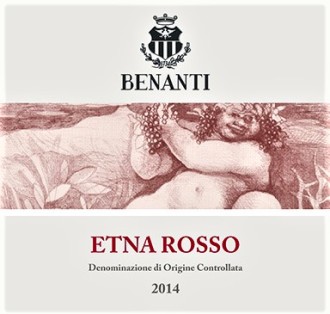 Other Red Blends from Etna, Mount Etna, Sicily, Italy
Other Red Blends from Etna, Mount Etna, Sicily, Italy
80% nerello mascalese
20% nerello cappuccio
13.5% alcohol
Purchased: 21 September 2017 – $19.99
Opened: 27 March 2018
els: 9.1/10
Wine Enthusiast: 94
Cellar Tracker: 89
The ancient Greeks arrived in southern Italy and Sicily 3000 to 2800 years ago, planting vines, among other, lesser endeavors, laying the ground work for an extensive Greek tourism outpost in the Iron Age. The Etruscans were quick studies and turned Tuscany into a wine haven soon after. Then came the Romans expanding the wine trade to their known world, much to everyone’s satisfaction. Italy is the number one producer of wine in the world with a 2017 output in excess of 1 billion gallons versus world-wide production of about 6.5 billion gallons. The greatest amount of Italian wine, by volume, is exported to Germany but the greatest amount by monetary value, is exported to the US. There are 4 main producing areas in the country; northeast, northwest, central and southern plus the islands, all further divided up into 20 regions, 408 DOCs and DOCGs, growing 396 prime varieties of grapes. White wine accounts for 54% of all wine produced in Italy with the remainder being red or rose. Sangiovese and Trebbiano grapes are the most common varieties planted.
Sicily, the largest island in the Mediterranean located near the western toe of Italy, likely was one of the first Italian areas the sea-faring Greeks planted vines on. They set up a robust trade in wine that continued with the Phoenicians and Romans. Today, Sicilian wine and food go hand in hand, creating gastronomic delights worldwide. The island is the 4th largest producer of grapes and wine in Italy by volume; equaling more than 10% of the country’s total. 58% of Sicily’s wine is white, slightly higher than Italy as a whole. There is 1 DOCG, 23 DOCs, and 7 IGPs on the island. About 25% of all wines produced are DOC or DOCG. Sicily produced 140 million gallons of wine in 2016. Catarrato and Nero d’Avola grapes are the most common grapes grown, amounting to 34% and 16% by acreage, respectively.
Etna DOC wraps around Mount Etna in eastern Sicily, covering the entire mountain slopes, except the northwest quadrant, from top to bottom, from the plains to more than 3500′ above sea level, covering it all in 5000 acres of vines. The vineyards contain some of the oldest vines in all of Europe, many over 100 years and some as old as 200 years. Four wines can be produced under the DOC. 1) Bianco: Carricante (minimum 60%), Catarratto (no more than 40%). 2) Bianco Superiore: Carricante (minimum 80%), Catarratto or Minnella (no more than 20%). Grapes have to come exclusively from the Milo area. 3) The most common DOC wine is Rosso or Rosato: Nerello Mascalese (minimum 80%), Nerello Cappuccio or Mantellato (no more than 20%). 4) Spumante: Nerello Mascalese (minimum 60%). More than 70% of the grapes produced in the DOC are Nerello Mascalese and Nerello Cappuccio. The volcanic soils contain a large percent of sand with clays and are very rich in minerals. Because of the elevation and azimuthal changes around the mountain, temperatures and rainfall vary dramatically from place to place.
The Nerello Mascalese grape, thought to have originated on the Mascali plain at the foot of Mount Etna, is possibly a child of the Sangiovese grape plus some other unknown variety. The grape is dark-skinned (nero-Italian for black), producing medium-bodied, dry wines with fairly high acidity. It is the dominate grape in Rosso wines.
Nerello Cappuccio, almost always used in blended wines, thrives on the higher elevations of Mount Etna. It is a sweet, dark-skinned grape with high tannins and acidity. It is usually blended with Nerello Mascalese to soften it up and add a brilliant ruby color.
The Benanti family winery, its origins dating back to the late 1800s, near the southeastern foot of Mount Etna in Catania, was revived and updated by Giuseppe Benanti in 1988. After many years of studying the local terroir he brought the proud grapes of the past into the modern world of wine making. His Etna vineyards are located on the northern, eastern, and southern slopes of the volcano. The company has additional vineyards in the southern tip of Sicily at Pachino and also at Pantelleria, a small island of the southwest coast of Sicily.
The Benanti vineyards are on the northern, eastern and southern slopes of Mount Etna from 1500 to 3000′ above sea level, totaling about 30 acres and producing about 30,000 cases per year.. The vines are 10 to 60 years-old growing in sandy volcanic soils. The vines grow with-in a highly variable humid, mountain climate with lots of sun.
The grapes are hand-picked in October, de-stemmed, crushed and fermented at 77°F in stainless steel vats coupled with a 3 week maceration. 80% of wine matures in stainless steel tanks while the remaining 20% is aged in French oak barrels for 8-10 months. They are further aged in the bottle for 2-3 months.
A brilliant pale ruby-red to a pale tawny wine with a tawny rim. A perfume of cherries and dark fruits. Light, dry and acidic with a wonderful, long finish.
I find this wine similar in structure to Pinot Noirs and Burgundies. I drank this wine while nibbling on strawberries and apples slices which I found very satisfying. It is a light wine and I would pair it with light fare such as a minestrone or Italian wedding soup.
An outstanding wine at an ok price. Drink this year but likely good until 2021-2022. Decant and aerate for one hour, or more, before drinking.
$16.98-21.99 wine-searcher.com